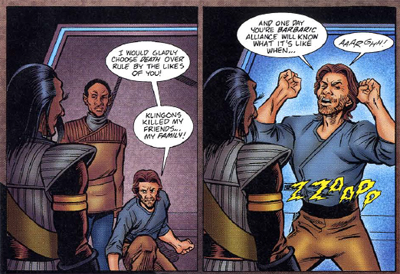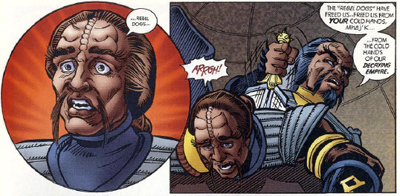This September and October, we’re taking a look at the jam-packed 1994 to 1995 season of Star Trek, including Star Trek: Deep Space Nine and Star Trek: Voyager. Check back daily for the latest review.
Enemies and Allies is a particular brand of oddity. It is the most throwaway story imaginable.
Continuing the trend of recruiting Star Trek actors to write for the comics, Malibu pursued Star Trek: Voyager regular Tim Russ to write for their monthly Star Trek: Deep Space Nine comic. Russ was ably assisted by Mark Paniccia. Paniccia was the editor for Malibu’s Star Trek comics. He co-wrote Rules of Diplomacy with Aron Eisenberg, and also wrote the script for the two-part Sole Asylum headlining the twenty-ninth and thirtieth issues of the Deep Space Nine monthly.
As with the other actors to write for the line and the Star Trek actors-turned-writers in general, Russ concentrates on his own character. He crafts a story based around Tuvok. However, it is quite clear that Malibu has not reached the stage where it could launch a Voyager comic. It was in the process of planning such a comic when Marvel bought the rights to license all Star Trek comics in 1996. As such, Tim Russ is tasked with writing a comic centring around Tuvok without taking place in the same continuity of Voyager.
The solution to this problem was quite ingenious, even if the execution was less than satisfying. Tim Russ would write a two-part short story centring around mirror!Tuvok, the character who fleetingly cameo-ed in Through the Looking Glass.
To be fair, this is a rather elegant solution to the problem of recruiting a Voyager actor to write for Deep Space Nine. At the same time, it feels like a parody of Star Trek spin-off storytelling. Much like the expansive Star Wars universe, there is a sense that virtually every character ever to wander on camera has their own history and back story. mirror!Tuvok may only have a couple of lines in a less-than-stellar episode of Deep Space Nine, but he’s still the central character of a two-part comic book story.
There is a sense that this is rather gratuitous. The mirror universe setting contributes to this sense of abstraction. While Mirror, Mirror and Crossover had used the mirror universe as a way to make clever and insightful observations about Star Trek as a franchise, Through the Looking Glass marks the point at which the mirror universe becomes the place the cast and crew go on vacation for a week.
With that third-season installment, the mirror universe becomes a place that makes even less logical sense than it did before, a place for pulpy adventures populated with space pirates and rebels and evil empires. It is a place for goofy throwaway adventures, to help the season reach the requisite twenty-six episodes expected from Star Trek. With the exception of Resurrection, all of the Deep Space Nine mirror universe episodes after Through the Looking Glass feel like an attempt to do a Star Trek flavoured “romp” through epic space fantasy.
In other words, Through the Looking Glass associates the mirror universe with excess. That sense of excess fits comfortably with the general mood and aesthetic of Enemies and Allies. It’s a story that exists because having Tim Russ write a Star Trek comic would be a pretty great coup for Malibu comics, in the same way that having Aron Eisenberg or Mark Lenard writing for the series would be. However, writing for Tuvok is a bit more complicated than writing for Nog or the previously unseen descendent of the Romulan commander from Balance of Terror.
To be fair to Malibu, the covers of the two issues don’t put undue emphasis on Russ’ contributions. Both issues tease the appearance of “the Mirror Tuvok!”, but neither cover makes reference to the celebrity co-author. There is a sense that the comic is aware of just how throwaway the story is, an enjoyable and inoffensive back-up feature that really feels like it has very little to add beyond back story for a character who appeared in a scene one time.
To be fair, it does seem like Russ has a clear grip on the character of Tuvok, even in this alternate universe. His performance was very influenced by Leonard Nimoy’s portrayal of Spock, and you can see that in his dialogue here. Tortured by the Klingons, it is suggested that mirror!Tuvok might be more likely to cooperate after an act of brutality. mirror!Tuvok replies, “I could no easier give my assistance now than before. To do so would mean compromising and betraying my beliefs.” Very Vulcan, very matter-of-fact. It is quite easy to read in Russ’ “Tuvok” voice.
There is a lot of potentially interesting material broached in Enemies & Allies, but none of it is given enough focus or attention to really work. We are told that the mirror universe is “a very dangerous place for Terrans and their Vulcan Allies.” One gets the sense that there is a story to be told here. Since Mirror, Mirror implied that the mirror!Vulcans were subjects in the Terran Empire, one wonders why they chose to side with their fallen oppressors. Have Vulcans learned to trust humans? Or is it as simple as suggesting that my enemy’s enemy is my ally?
The script alludes to the plight of the mirror!Vulcans a couple of times. “You are most intelligent, Vulcan,” a Klingon comments. “A pity your people do not take part in the Alliance.” Were they invited? Did the Klingons and Cardassians consider recruiting them during the decline and fall of the Terran Empire? Are there other races that the audience associates with the Federation who have joined the Alliance? This sort world-building would be intriguing, but perhaps beyond the growing sense that the mirror universe is primarily a place for self-styled “fun romps.”
Similarly, the story ends with a twist – a member of the Klingon crew decides to fight to reclaim his honour. It’s a potentially interesting angle, even if it feels like it over-simplifies matters somewhat. Surely the Klingon ideal of honor allows for what the Alliance is doing? Presumably the narrative of this conflict would paint the rebels as dishonourable combatants? The idea of dissent within the Alliance is fascinating, but hampered by the decision to treat it as a twist ending (appearing on the final page), rather than a plot point to be developed.
However, despite these potentially interesting developments, Enemies & Allies never feels like more than simply a throwaway pulpy adventure. As such, it perfectly captures the spirit of the mirror universe at this point in time.
You might be interested in our reviews of the third season of Star Trek: Deep Space Nine:
- The Search, Part I
- The Search, Part II
- House of Quark
- Equilibrium
- Second Skin
- Supplemental: Fearful Symmetry by Olivia Woods
- The Abandoned
- Civil Defense
- Meridian
- Defiant
- Supplemental: (Malibu Comics) #29-30 – Sole Asylum
- Fascination
- Past Tense, Part I
- Past Tense, Part II
- Life Support
- Heart of Stone
- Supplemental: (Malibu Comics) The Rules of Diplomacy
- Destiny
- Prophet Motive
- Supplemental: The 34th Rule by Armin Shimerman & David R. George III
- Visionary
- Supplemental: (Malibu Comics) Blood and Honour
- Distant Voices
- Through the Looking Glass
- Supplemental: (Malibu Comics) #29-30 – Enemies & Allies
- Supplemental: The Soul Key by Olivia Woods
- Improbable Cause
Filed under: Comics, Deep Space Nine | Tagged: Comics, malibu, Mirror Universe, star trek, star trek: deep space nine, star trek: voyager, Tim Russ, tuvok |


























Leave a comment